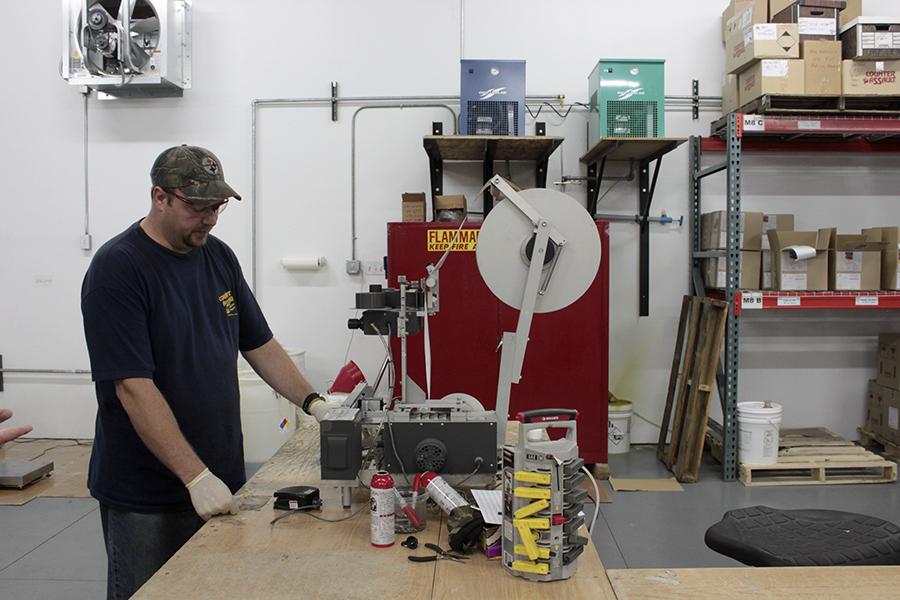In Glacier National Park, it’s easy to spot the distinctive red canisters clinging to hikers’ backpacks and belts.
In the cultural mindset, bear spray is winning over the traditional firearms carriers when it comes to defending against agitated bears. Studies and incident reports continue to demonstrate the spray’s higher effectiveness and the compact accessories have become increasingly commonplace, at least among frequent outdoor enthusiasts who believe with assurance that in a time of great need — like when a 500-pound grizzly is charging at 25 miles per hour — that canister will come in handy.
At the forefront of this sea change is Counter Assault, a Kalispell-based manufacturer that developed the first consumer bear spray and now produces hundreds of thousands of units each year to distribute across the globe from its compact facility on U.S. Highway 93 South.
“We’re a small company that does big things,” says George E. Hyde, the company’s general manager.
Counter Assault’s nine employees create, among other products, 8.1 and 10.2 oz. bear deterrent canisters packed full of the fundamental compound: oleoresin capsicum, a thick liquid that is made from the extracts of hot cayenne peppers, including the spray’s active ingredient, capsaicin. There are also a few secret ingredients that make Counter Assault unique, Hyde says, and the overall product is considered a standard-setter by the Environmental Protection Agency.
“We’ve been in the business longer than anybody else and we use the best ingredients,” Hyde says.
The company continues to evolve with its line of personal defense products, including compact-sized pepper spray, and the latest creation is its electric bear fence. The 53-foot orange mesh fence is portable with 8,000 volts that can run for up to 40 days. It’s intended to be used by outfitters, guides or residents who live in bear country.
But the company’s bread and butter — bear spray — is a proven tool that can be found in major retailers around the world. It’s especially popular in Canada and Japan, Hyde says.
And it all comes from a facility in the heart of the Flathead Valley, where the company’s owner — Pride Johnson — relocated from Missoula in 1999.
Counter Assault’s canisters deploy a “shotgun-cloud spray” that shoots roughly 75 mph, reaches 32 feet and lasts up to 9.2 seconds. The cloud pattern is intended to create a barrier between a human and approaching bear. The nasal cavity takes up a large portion of a bear’s skull, leading to an enhanced sense of smell.
“Bears live by their nose. They can smell a dead animal a mile away,” Hyde says.
The bright-red spray hits a bear and attacks its senses, burning its lungs, nose and eyes. Naturally, the bear flees the situation as fast as possible, and without any lasting impacts other than a new awareness of humans.
That newfound awareness, according to Gary Moses, is changing the way bears feel about humans.
Moses served as a park ranger for more than 20 years in Glacier Park and was a recipient of the Harry Yount National Park Ranger Award, the position’s highest honor. In all his years working in the wild, he noticed the supreme effectiveness of bear spray, and he believes over time the red canisters have changed the way bears think about humans.
“I can’t prove it statistically, but the more people who carry bear spray and the more times bears get sprayed, the more bears will learn to stay away from people because of that negative association,” Moses says. “They don’t get that with firearms. If they get shot, they are dead or they injured somebody, and there’s no learning that goes on.”
Since the use of bear spray proliferated in the last two decades, more bears have been doused and lived to tell the tale, so to speak. Moses believes sows that have been involved in a spray incident are more likely to teach their cubs to stay away from humans, and from there the ripple effect continues.
“I really think the more they get sprayed, it changes the bear. Bear spray puts the human into the bear’s social hierarchy,” says Moses, who has joined Counter Assault as an ambassador spreading awareness and education about being in bear country.
Northwest Montana is home to the largest grizzly bear population in the lower 48, with more than 1,000. Another 740 live near Yellowstone. The state’s black bear population is estimated to be roughly 13,000.
In other words, Montana is bear country, and as national and state parks draw more and more visitors, the likelihood of encounters is statistically likely to increase.
Or maybe not.
“The number of encounters might be increasing but I think in the long run, if people continue to use bear spray as intended the number of injury events will continue to decrease,” Moses says.
When it comes to protecting human life, there is statistical evidence that bear spray is more effective than firearms. Tom Smith and Stephen Herrero, a pair of bear research ecologists, conducted an extensive study of bear encounters. The researchers examined records of every bear encounter in Alaska from 1985 to 2006. According to their research, 56 percent of the people who used a firearm to ward off a bear were injured and 61 percent of those bears were killed, either at the time or later. When it came to incidents involving bear spray, humans escaped unharmed 98 percent of the time, and zero bears were killed.
“It’s a no-brainer,” Moses says.
For more information about Counter Assault, visit counterassault.com.
